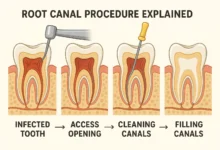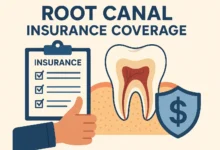Root Canal Pain Relief Tips: Natural Remedies and Quick Fixes
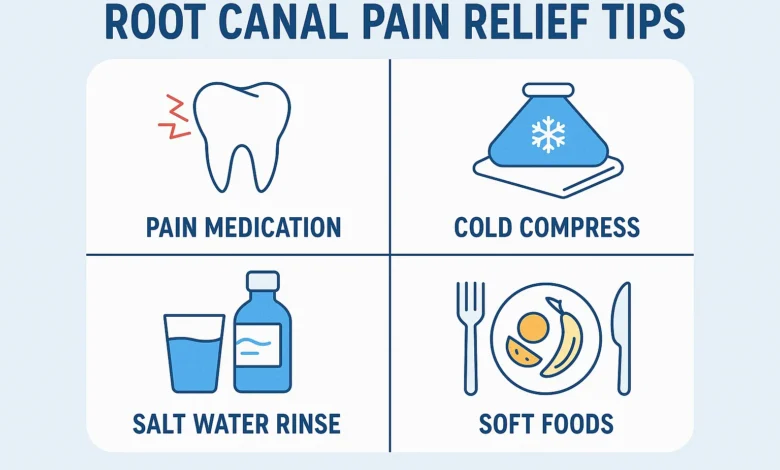
Root Canal Pain Relief Tips: Your 2025 Guide to Managing Discomfort Before and After Treatment
It is not just an irritation, that dull aching toothache, the one that acts up every time one drinks coffee or swallows food. It’s a signal. When your dentist tells you to have a root canal, that alone may be sufficient to trigger panic.
But suppose the anxiety of pain is more horrible than the operation? The real thing is that nowadays root canal treatment has become extremely comfortable due to modern endodontics. Nevertheless, it is vital to work on the pain prior to the surgery and provide a pain-free recovery afterwards. This is the ultimate guide to the correct root canal pain relief tips that can make you more knowledgeable and place an individual in control of the comfort again.
We will break down the science of root canal pain, give you a straightforward action plan to relieve pain now, and we will also unravel evidence based strategies vs. old wives tales. You need a root canal pain relief home remedy to get you through to your appointment or you need to know what the best pain medication is to use in root canal recovery, this is your one stop shop.
Why Does a Root Canal Hurt? Knowing the origin of Suffering.
In order to manage the pain, you need to understand its source. It is not the hard enamel of the tooth that causes you pain; you are feeling it deep in the pulp.
Analogy: Consider your tooth just a house. The exterior (enamel and dentin) is hard, and the interior is the living part (pulpmade up of nerves, blood vessels and connective tissue). Infection and inflammation occurs when bacteria enter this space via a deep cavity or crack or trauma. Since the pulp is surrounded by hard tissue, the swelling cannot escape anywhere, and the pressure and pain become excruciating. This is known as pulpitis.
This is also the reason why root canal pain relief is the objective of a root canal. The process will eliminate the infected pulp, which is the source of the pain. Any pain that occurs after the procedure is normally associated with healing of the tissues around the area.
Immediate Action Plan: Root Canal Pain Relief Before Treatment
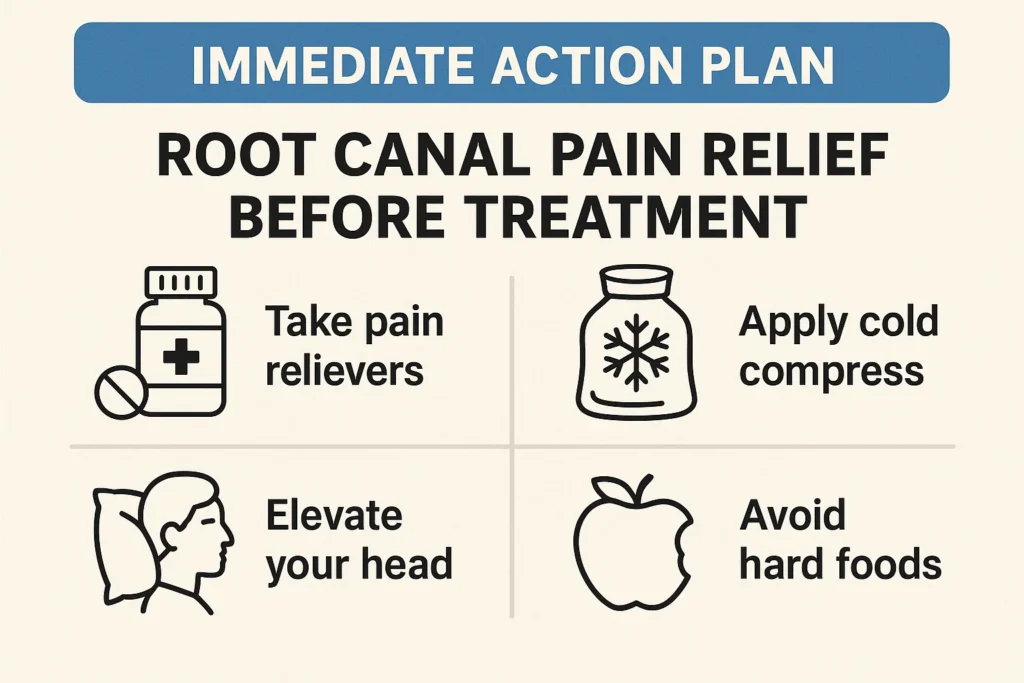
Waiting for your scheduled appointment can be agonizing. Here’s a step-by-step guide on how to deal with root canal pain in the interim.
1. Medication Management: The First Line of Defense
Over-the-counter (OTC) medications are the most effective way to manage pre-treatment pain and inflammation.
- Ibuprofen (advil, motrin): This is usually the best suggestion. It is a non-steroidal anti-inflammatory drug (NSAID), and it actually attacks the inflammation that is the source of the pressure and pain. Research has shown that ibuprofen is very effective in dental pain.
- Acetaminophen (Tylenol): It is a pain killer but not an anti-inflammatory. It may be useful in itself as to the sensation of pain. In the case of severe pain, other dentists suggest taking ibuprofen and acetaminophen by alternating them (only after consulting with them or your doctor).
- Aspirin: Aspirin may be an NSAID, but it is not the preferred drug when dealing with dental pain as it is a blood-thinner, which could lead to stomach ulcers.Pro Tip: It is always good to take medicine with food and to take the amount of medicine that is recommended on the label. Do not put a pill directly against the gum close to the painful tooth since it will burn.
2. Effective Home Remedies for Temporary Relief
These root canal pain remedies can provide complementary comfort while you wait for your appointment.
- Salt Water Rinse: Add half a teaspoon of salt in warm water. Swish carefully and spit 30s. This is a natural disinfectant which can be used to reduce bacteria besides calming inflamed gums.
- Cold Compress: Using an ice pack, or a bag of frozen peas in a towel, place it on the outside of your cheek, over the area of pain and keep it there 15 minutes at a time. This narrows blood vessels, which decreases the swelling and desensitizes the pain.
- Raise Your Head: When resting lie down but support your head with an added pillow. This will not allow the pooling of blood in the head and this leads to throbbing pain.
3. What to Avoid Before Your Root Canal
Certain behaviors can exacerbate the pain.
- Avoid Chewing on the Affected Side: This prevents food particles from aggravating the area and reduces pressure on the tooth.
- Steer Clear of Extreme Temperatures: Very hot or cold foods and beverages can trigger sharp, shooting pain.
- Skip Sugary and Hard Foods: Sugar feeds bacteria, while hard foods can cause further damage.
Pain Management During the Root Canal Procedure
The first major fear is the pain during the process, so, we will talk about it directly. The idea of a root canal being painful is an antique.
According to clinical data, the discomfort with the modern root canals is the same as having a normal filling. The secret is good local anesthesia. Your endodontist will use a numb to ensure that the tooth and surrounding area is completely numbed. There will be pressure, movement, but you are not supposed to experience sharp pain. Provided that you do, a mere signal to your dentist will lead to additional anesthetic.
Your Guide to a Pain-Free Recovery: Root Canal Pain Relief After Treatment
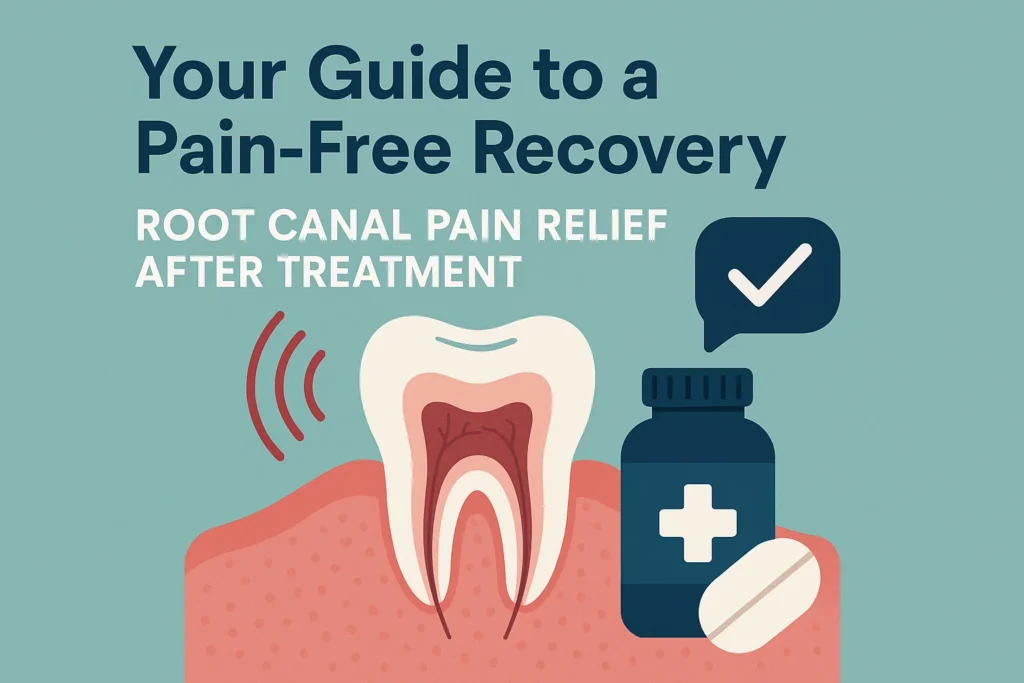
After the completion of the root canal, the cause of the infection has disappeared. But the ligament and the bone around the root of the tooth have undergone a major operation. A little bit of tenderness is normal as such tissues are healing. This is the way to get rid of pain after root canal treatment.
1. Post-Procedure Medication Protocol
Your dentist will provide specific instructions, but here’s what you can generally expect.
| Medication Type | Purpose | Timing & Notes |
|---|---|---|
| OTC Ibuprofen | Manage inflammation and soreness | Often recommended for 2-3 days. Take as directed with food. |
| Prescription Pain Reliever | For more significant pain (less common) | Use only if prescribed. Follow instructions precisely. |
| Antibiotics | Fight active infection | Not always needed. Complete the full course if prescribed. |
2. The First 24-48 Hours: Critical Healing Window
- Stick to Soft Foods: Yogurt, mashed potatoes, soup, and smoothies are your friends.
- Continue Cold Compresses: Use them for the first day to minimize swelling.
- Practice Gentle Oral Hygiene: Brush carefully but avoid vigorous rinsing or spitting for the first day to protect the blood clot.
- Get Plenty of Rest: Your body heals best when it’s not under stress.
3. When to Switch to Warm Compresses
After 48 hours, in case you continue to experience stiffness or tenderness in your jaw, change to warm, moist compress. The heat will loosen muscles and raise the blood flow to expedite healing.
Red Flags: What to do when you need to see your dentist at once.
Whereas some pain is normal, some symptoms require an immediate call to your dentist. This might point at a complication.
- The pain is acute, and is intense and unresponsive to prescribed medication.
- Swelling within or without your mouth that is growing.
- The pre-treatment pain symptoms reappear.
- Symptoms of allergy (rash, hives, itching).
- The temporary filling is totally lost.
Veneers Installment Plan: Affordable Options for a Beautiful Smile
Frequently Asked Questions (FAQ)
Q: What is the best pain relief for root canal pain?
A: Ibuprofen (Advil, Motrin) is the most effective OTC medication in most individuals as it will actually decrease the inflammation that is causing the pain. Acetaminophen (Tylenol) should be used in case you are unable to take NSAIDs as an alternative analgesic. Talk to your dentist or doctor to get specific recommendations always.
Q: What is the duration of the root canal pains following the procedure?
A: It is common to have tenderness during several days to one week. It may take the surrounding gum some time to be sensitive to biting pressure. This agony must slowly reduce on a daily basis. When pain increases or continues longer than one week, then call your dentist.
Q: Does is cause pain in the area of a root canal?
A: Yes, absolutely. That is why you need the procedure because of the pain you are experiencing before the procedure. The major causes of discomfort are the infection and inflammation within the tooth. The cure to that pain is the root canal treatment.
Q: Is it possible to take clove oil as a pain reliever in root canals?
A: Clove oil is made of eugenol, a natural anesthetic/antiseptic. It may give short term help in root canal pain. It should be applied with great caution though. Dilute one drop with a carrier oil (such as olive oil) and put it in a cotton swab and put it on the tooth and gum. Caution: It should not be overused, because it may harm the gum tissue. It is not in lieu of professional treatment.
Q: How does a root canal pain differ with a regular toothache?
A: A root canal is normally necessary when a toothache is long-lasting, painful and a product of hot stimuli (which usually signifies a non-vital or dying nerve). It can also be accompanied by swelling, pimple on the gum or even darkening of the tooth. General tooth pain may be either sporadic or sensitive mostly to cold or sweets.
Conclusion: From Pain to Peace of Mind
The procedure of going through the pain of a necessary root canal might be a difficult process, and yet it is something that one can cope with. These are the main lessons that have been learned: root canal pain management can be achieved with the combination of strategic OTC medication, basic home care and straightforward communication with your dental practitioner. The process in itself is meant to do away with your pain and not to make you suffer.
Knowing the reason behind the pain and a tangible plan of how you will alleviate pain at all phases of root canal problems will make you able to substitute anxiety with confidence. It is not only about surviving the procedure, but to come out the other end with a pain-free healthy smile.
Your Next Step: In case of dental pain, the first step you are going to take is to make an appointment with a dentist or endodontist. When the infection is delayed, it will progress. Relieve yourself with the tactics in this guide, until you find professional treatment to solve the problem permanently.


